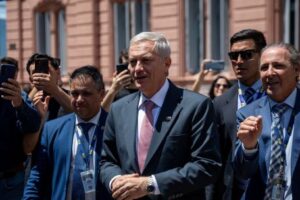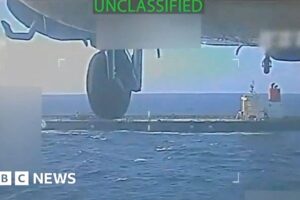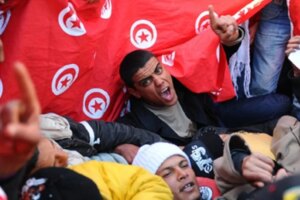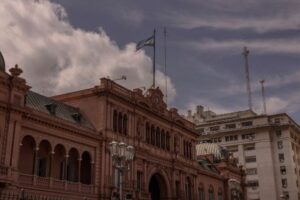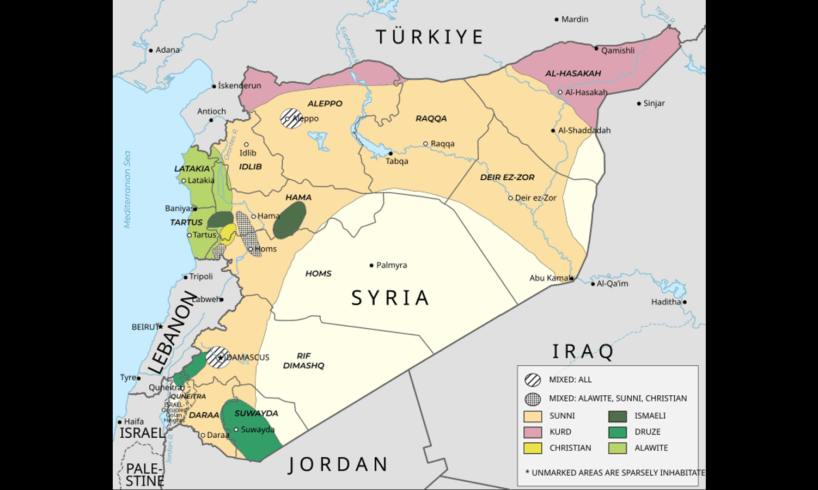
Last December, the US—and its regional allies—celebrated the rout of Syrian President Bashar al-Assad’s regime at the hands of al-Qaeda offshoot and US-designated foreign terrorist organisation Hayat Tahrir al-Sham (HTS).
Its jihadist leader and soon-to-be President Ahmad al-Sharaa had a $10 million US bounty on his head. Virtually overnight, Al-Sharaa and HTS became the darlings of Western media outlets, offering the arrival of democracy and peace to Syria.
Washington views al-Sharaa and HTS, which the US and Turkey had supported, as a bulwark against Iran and Russia’s return to influence in Syria. Control over Syria would be a key element in countering China’s growing economic influence in the Middle East and reasserting the US’s position as the dominant external economic and political power in the Middle East, with its energy resources and strategically important trade routes to the Eurasian landmass.
The ethno-religious composition of Syria [Photo by Tanvir Anjum Adib / CC BY-SA 4.0]
Moreover, the antagonistic interests of the imperialist powers and the regional powers of Israel, Turkey and the Gulf states that have backed Sharaa in their bid to control Syria has the potential to ignite further waves of bloody sectarian violence and precipitate the fragmentation of the country that itself could ignite a region-wide conflagration.
The al-Sharaa government
Al-Sharaa’s sudden ascent to power in Damascus, after a 13-year war for regime change financed, armed and supported by the Gulf states, Turkey, the US and Israel, came in the wake of the US-backed Israeli war of extermination against the Palestinians in Gaza. At the same time, Israel carried out attacks on Hezbollah in Lebanon, an Iranian ally that along with Iran and Russia had helped Assad maintain power in Syria, escalating to a full-blown war last October that caused $12 billion damage, as well as thrice weekly bombing of Syria aimed at weakening Iran’s presence in the country.
Israeli Prime Minister Benjamin Netanyahu had seized on the Palestinian attack against Israel in October 2023 as the pretext for a long-planned war to emasculate Iran’s allies that was part of Washington’s broader project of a “New Middle East.” Washington and Tel Aviv followed this up with an unprovoked war on Iran in June, even as the Trump administration was supposedly conducting peace negotiations with Tehran’s bourgeois clerical regime.
Damascus was the only regional capital not to condemn the massive Israeli bombardment of Iran. This was bound up with the Sharaa government’s alignment with Washington and the regional countries such as Turkey, UAE, Qatar and Saudi Arabia against Iran and Hezbollah in Lebanon, against whom it had fought in Syria, as a means of consolidating its power internally. To this end, it has even sought to reach some accommodation with Israel, including reining in the Palestinians in Syria and closer control of the border with Lebanon to prevent the shipment of weapons to Hezbollah, even mooting the normalisation of relations with Israel.
A masked fighter carries a flag of the Al-Qaeda linked Hayat Tahrir al-Sham (HTS) in the courtyard of the Umayyad Mosque in the old walled city of Damascus, Syria, on Tuesday. (AP Photo/Hussein Malla)
Sharaa’s domestic policies are no less reactionary, favouring big business, the privatisation of public infrastructure, free market competition and Islamic law. The Interim government has announced plans to lay off between one third and one half of all public sector workers, claiming many were receiving a salary without working and abolish the requirement for businesses to register their workers for social insurance. It has removed the bread subsidies upon which millions depended and plans to reduce or even remove entirely the subsidies on electricity prices because “prices are very low, much below their costs”.
Beholden to the Turkish government, the HTS interim government has reduced import duties on a wide range of Turkish products, leading to a huge rise in imports and is discussing renewal of the 2005 Free Trade Agreement between the two countries that was suspended in 2011. These developments are expected to adversely affect Syrian producers and further impoverish Syrian workers and rural masses.
US push to control Syria
The Trump administration is backing the establishment of a united Syrian state with a centralised government under al-Sharaa that controls the entire country, to bring an end to Syria’s present fragmentation.
While the government controls the main population centres on the north-south axis from Aleppo to Damascus, the Syrian Democratic Forces (SDF) and Kurdish People’s Protection Units (YPG) control around one third of the country, the eastern region where most of Syria’s oil and gas resources, its best farmland and a dam that powers much electricity, are located. They are backed by an estimated 2,000 US troops, ostensibly there to combat Islamic State (IS) that operates in Syria and Iraq and to counter Iranian influence in the region. US President Donald Trump has already declared his intention of withdrawing the troops.
President Donald Trump, Crown Prince Mohammed bin Salman (left) and Syrian President Ahmad al-Sharaa (right), May 14, 2025
The Druze, a religious sect living in Lebanon, northern Israel, southern Syria and northern Jordan, control the region south of Damascus, while Turkish-backed Islamist militias under the banner of the Syrian National Army (SNA) control areas along Syria’s northern border with Turkey aimed at preventing any link-up between Syria and Turkey’s Kurds.
Tom Barrack, US envoy to Syria, has insisted Syria should be “one country,” without autonomous rule for its 700,000 Druze, 2-3 million Kurdish or 2.7 million Alawite communities, but warned against taking unilateral action that could threaten regional stability. He told the New York Times this month the US was not making democratisation and inclusivity criteria for its relations with Damascus, condemning past US attempts at “nation building” and meddling in the domestic affairs of countries in the Middle East. This prompted some Kurds in and outside Syria to accuse Washington of betraying its long-time allies.
The Kurds and Druze militias have signed an agreement with al-Sharaa to disarm and join the Syrian army, even as they insist on some degree of local autonomy. In the case of the Kurds, this is seen as key to ending Turkey’s war against the YPG, which it views as a partner to the Kurdistan Workers Party (PKK)—deemed a terrorist group and threat to Turkey’s national security. Ankara has fought a long and bloody war against the PKK that has killed at least 40,000 people, destroyed at least 2,000 villages and driven around 2 million Kurds from their homes to the cities.
Syrian President Ahmed al Sharaa and Syrian Democratic Forces (SDF) leader Mazloum Abdi agree to dissolve the SDF into the Syrian transitional government, March 10, 2025 [Photo: Syrian Arab News Agency (SANA) – Presidency of the Syrian Arab Republic]
Ending the long running conflict between Ankara and the Kurds would enable the US to hand over the responsibility for continuing the war against ISIS to Turkey, its NATO ally with the second largest army, and Syria and withdraw its forces from Syria.
Turkey’s President Recep Tayyip Erdoğan said this would bring positive gains for his country, “Syrians in our country have voluntarily returned (after the fall of the Assad regime). We will continue supporting returns. With more returns, Syria will regain a sense of normalcy, and we will have a more stable southern border”.
Syria’s energy resources and infrastructure
Most of Syria’s oil and natural gas resources, which before war provided an important source of revenue for the government and made the country self-sufficient and an energy exporter, lie in eastern Syria, largely under Kurdish control. After the war broke out in 2011, oil production fell to around 15 percent of its former output, forcing the government to obtain oil on a credit line from Iran, whom it now owes between $30-50 billion which the new regime has refused to pay.
Map of Syrian oil fields, pipelines and refineries, as of August 21, 2011 [Photo: US Geological Survey/US federal government]
While Syria has not started offshore exploration for oil and gas, it is highly likely that like Egypt, Israel, Gaza and Lebanon, it has oil and gas resources in the eastern Mediterranean that will become a focus for the international energy-exploring corporations. However, while Ankara would like to define its offshore waters vis a vis Syria, this is likely to cause friction with Cyprus and Greece that would turn to Washington and Brussels for support.
Al-Sharaa is determined to reassert Syrian control over the Kurdish region to secure its oil revenues and the country’s electricity supply which even in Damascus, the best supplied part of the country, is available only one hour in six, making daily life unbearable for the vast majority without access to their own solar power or generators.
Ankara supports al-Sharaa because it wants an end to any Kurdish entity that might encourage similar secessionist trends in Turkey itself. It is already supplying electricity to the Idlib region in north-west Syria and has started to repair power plants in Syria and with Qatar, is to deploy floating power-supply vessels to Syria. Israel too could supply electricity if Damascus were to agree to normalise relations with Tel Aviv, which would enable Syria to become a transit state for gas exports from Israel and Egypt to Turkey and Europe.
According to reports by the World Bank and International Monetary Fund (IMF), reconstructing Syria’s infrastructure and battered economy after 13 years of war that has left 90 percent of Syria’s 23 million population below the poverty line and 16.7 million people dependent upon humanitarian aid could cost $3-400 billion. This is far greater than Syria’s pre-war GDP of around $60 billion or $4,000 per capita, now down to just $17.5 billion or $760 per capita, while both the government and the Central Bank are essentially broke.
It was the prospect of these commercial opportunities that prompted Turkey and the Gulf states to press the US to lift sanctions on Syria. During his visit to Riyadh in May, which focused on limiting Beijing’s influence in the region and agreeing business deals with Arab countries with strong ties to his and his family’s business interests, Trump held a 30-minute meeting with al-Sharaa. He praised him as a “Young, attractive guy. Tough guy, you know. Strong past—very strong past. A fighter.”
When he announced that he would lift US sanctions on Syria’s new government to give the country “a chance at peace”, his audience gave him a standing ovation.
The end of US sanctions would enable Turkey and the Gulf to try to integrate Syria, along with Lebanon where Israel’s massive aerial bombardment of Hezbollah strongholds, weaponry and personnel has eroded the group’s power, into their spheres of economic and political influence. As yet, the political stalemate in Lebanon, despite Israel’s emasculation of Hezbollah, has stymied any investment by the Gulf states or political agreement on the economic measures that would secure a loan from the US-dominated International Monetary Fund.
Smoke billows following Israeli airstrikes in Dahiyeh, Beirut, Lebanon, Wednesday, Nov. 13, 2024 [AP Photo/Hassan Ammar]
There were celebrations a few weeks ago when the Trump administration announced it had taken the administrative and legal steps to unwind US sanctions and remove HTS from the US list of Foreign Terrorist Organizations. This serves to reintegrate Syria into the global financial system, enabling the Gulf states and Turkey to make significant financial investments.
Ankara is reportedly to begin the rebuilding of the Syrian army and Saudi investors plan to invest $6.4 billion in Syrian infrastructure, real estate, telecommunications and other key sectors. The UAE-based DP World, which operates dozens of marine and inland ports and terminals globally, particularly in Asia, Africa and Europe, has signed a $800 million deal to develop the port of Tarus, conditional upon Sharaa expelling Hezbollah. It follows the signing in May of a 30-year contract with French shipping corporation CMA CGM to develop and run the port of Latakia and a $7 billion energy deal with a consortium of Qatari, Turkish and US companies as part of efforts to revive its crippled power sector.
China in Syria
At the heart of Trump’s decision to lift sanctions was his determination to prevent China from taking advantage of Syria’s economic isolation from the international financial system and reaping the resultant commercial and geopolitical profits. Beijing has become the Middle East’s most important trading and investment partner and specialises in exactly the kind of infrastructure reconstruction needed in Syria.
While China supported Syria during the 13-year long war, this was political and diplomatic, not economic or military. It vetoed some eight resolutions at the UN Security Council, defending Syria against foreign interventions, part of its broader stand in favour “non-interference” and “respect for national sovereignty”. Its abstention on a UN Security Council resolution on Libya in 2011 cost it dearly, forcing Beijing to evacuate its 30,000 civilians working there on construction sites.
While Beijing maintained close ties with Assad during the war, it carried out little trade or investment. Its investments and construction contracts in Syria, all begun before the war, totalled little more than $4.6 billion. Despite Syria joining China’s Belt and Road Initiative in 2022 and Assad’s state visit to Beijing in 2023, trade between the two countries had fallen from $1.27 billion in 2018 to $356 million in 2023.
Xi Jinping Meets with President of Syria Bashar al-Assad, September 22, 2023 [Photo: Embassy of the People’s Republic of China in the United Kingdom of Great Britain and Northern Ireland ]
Nevertheless, Assad’s ouster constituted a severe setback for China which fears that it might affect countries such as Egypt, Saudi Arabia and the UAE, where it has billions in investment, trade, and infrastructure at stake. The region is also important as a transportation route for its energy imports and manufacturing exports via the Suez Canal, Bab al Mandab Strait and the Straits of Hormuz, upon which it is reliant.
The new HTS government has largely shunned China, which sent senior officials earlier this year to Damascus to discuss potential infrastructure investment. More recently a large delegation of Chinese companies, second only to Turkey’s, attended a reconstruction conference in Syria. In May, Syria signed a memorandum of understanding with a Chinese company for investment in towns in Homs and RIF Damascus provinces.
Israel’s push to divide Syria
A key issue in stabilising HTS rule over Syria is its ability to take control of the eastern oil and gas producing region, currently controlled by Kurdish separatists, the YPG, and the southern, mainly Druze, region. It has come up against Israel, which lobbied the Trump administration for the cantonisation of Syria, to keep it weak.
Available from Mehring Books
The struggle against imperialism and for workers’ power in Iran
A pamphlet by Keith Jones
Israel responded to Sharaa’s ouster of the Assad regime by vastly stepped up its bombardment of the country. Its warplanes carried out hundreds of sorties, knocking out Syria’s air defences, 70 percent of the army’s critical assets and Syria’s intelligence archives. It branded the new regime as a government of “terrorists”. The bombardment served to ensure that Israel could use Syrian airspace to attack Iran and also undermine Sharaa’s efforts to regain control of territory controlled by other groups, including the Kurdish YPG.
Israeli soldiers stand next to an armored vehicle at the line that separates the Golan Heights from Syria, on December 9, 2024. [AP Photo/Matias Delacroix]
On the ground, the Israeli military crossed and seized huge swathes of Syrian land on Israel’s northern border. Israel has occupied Syria’s Golan Heights since the 1967 Arab Israeli war, annexing it in 1981 in defiance of international law. Following the collapse of the Assad regime, it seized a UN-monitored buffer zone, parts of Quneitra and Daraa provinces and the strategically important Mount Hermon on the Lebanese border, establishing a number of military bases there, under the pretext of protecting Syria’s Druze minority. It has in effect replicated Turkey’s control over swathes of northern Syria.
This prompted no opposition from the imperialist and regional powers and only very muted criticism from Damascus.
In January, however, Israel caused uproar after the publication of a controversial map by Israel’s Foreign Ministry showing the biblical Kingdom of Israel that includes significant portions of modern-day Jordan, Lebanon and Syria. Netanyahu declared, “the Golan will be part of the State of Israel for eternity” and said he would not allow the Syrian army to operate anywhere south of Damascus, thereby preventing it from re-establishing control over the southern region, including its border with Jordan.
Syrian civilians, hands raised, before Israeli soldiers, leave their homes in the Occupied Syrian Golan, 1967 [Photo: Unknown author – Al-Marsad – Arab Human Rights Center in Golan-Heights]
Foreign Minister Gideon Sa’ar, speaking at a European Union-Israel meeting, stoked separatism. He called for Syria to be broken up into separate autonomous states according to their ethnic and/or religious composition. This followed an earlier statement when he declared, “The Kurdish people are a large nation, one of the largest stateless nations. They are our natural allies,” adding, “They are a national minority in four countries, with autonomy in two of them— de facto in Syria, and de jure, in Iraq’s constitution. They suffer from oppression and aggression from Iran and Turkey. We must reach out to them and strengthen our ties. There are both diplomatic and security dimensions to this.”
In early March, Netanyahu described Syria’s new government as “radical” and said, “If the regime harms the Druze, it will be harmed by us.”
More recently, Israel’s plans for a so-called David’s Corridor have surfaced, sparking fears that the Netanyahu government aims to establish a Greater Israel. Traversing southern Syria, the Corridor would link Daraa province with the US al-Tanf base, near the border with Jordan and Iraq, and the Euphrates in the Kurdish-controlled territory in the east. This could provide a transportation route to northern Iraq and the potential to bring oil and gas to the Mediterranean port of Haifa rivalling projects mooted by Turkey and the Gulf states.
Israel Prime Minister Benjamin Netanyahu addresses the 79th session of the United Nations General Assembly, Friday, September 27, 2024. He held up a map depicting the entire Middle East as a “cursed” zone. Other maps he displayed showed Gaza and the West Bank as parts of Israel. [AP Photo/Richard Drew]
Israel’s moves in Syria has increased tensions with Turkey, Washington’s other ally in the region, prompting Ankara to seek a new agreement with the Kurdistan Workers Party (PKK), promoting a reactionary “Turkish-Kurdish-Arab” alliance, with the support of the PKK’s imprisoned leader Abdullah Ocalan, who has called for the PKK to disband, to counter Israel’s expansionist ambitions in the region.
Earlier this month, more than 1,400 people, mainly Druze, were killed in armed clashes between Druze groups and Bedouin tribes in the southern province of Sweida, triggered by a seemingly minor dispute over the cargo of a vegetable truck at a checkpoint. More than 170,000 people were displaced from their homes and essential services left in ruins. Al-Sharaa, thinking he had Washington’s support in asserting regime control, sent in the army to support the Bedouin against the Druze.
Israeli forces intervened—under the pretext of preventing “hostile forces” approaching its border, later switching to “supporting the Druze”—in a bid to remove Syrian forces from the region that Netanyahu had demanded remain demilitarised. It carried out more 160 aerial strikes across southern Syria and bombed Syrian General Staff headquarters and targets close to the presidential palace in central Damascus. The clashes prompted Jordan to deploy forces to its border with Syria to prevent the clashes spreading into its territory.
Damage in the Syrian General Staff complex in Damascus following the Israeli airstrikes [Photo: Syrian Ministry of Defense – Syrian Ministry of Defense]
The conflict has led to a major humanitarian crisis in the province.
US officials were reportedly taken aback by Israel’s intervention, with Secretary of State Marco Rubio declaring that the situation was “complicated” and that it “looks like a misunderstanding”. After “talks with all parties”, he called on Syria to withdraw its troops “to allow for a de-escalation,” while warning that the conflict was a “direct threat to efforts to help build a peaceful and stable Syria.” The State Department later said, “The US did not support recent Israeli airstrikes”, in effect warning Israel to keep out of Syria’s sectarian politics that might endanger American interests.
Al-Sharaa has withdrawn his forces, leaving the Druze in control of the region, and repeated his promises to protect Syria’s religious minorities that are fearful of the Sunni Islamists now in charge of the country, particularly after the massacre of 1,700 Alawites in Latakia in March and the June attack on the Mar Elias Church in Damascus, probably by HTS militias, in which 25 people were killed.
Government forces secure the exit of Bedouin families from Suwayda city, 21 July [Photo: Syrian Ministry of Interior – Syrian Ministry of Interior]
Turkey, which is opposed to Israeli support for autonomous regions in Syria, called for an end to Israeli military attacks. Deputy Foreign Minister Nuh Yilmaz told the UN Security Council during a meeting on Syria, “Israel’s disregard for law, order, and state sovereignty reached new heights with its recent attacks on the presidential complex and the Defence Ministry. The situation has partially improved as a result of our collective efforts with the US and some other countries.”
Ankara, fearing this may embolden the Kurds in Syria’s north-east to persist in their demands for autonomy, is calling for Israel to withdraw from all Syrian territory and return to the lines established in the Separation of Forces Agreement of 1974. It wants the Trump administration to adopt this position and Sharaa to condition any agreement with Israel on this.
As with all such conflicts in the Middle East, the Socialist Equality Group, Turkish section of the International Committee of the Fourth International has stressed, “The only way forward in Syria, devastated by a regime-change war supported by imperialism and now the scene of a dangerous power struggle between various regional and local forces, is through an international socialist perspective that will unite all workers beyond ethnic, religious, or sectarian divisions in the struggle for workers’ power against imperialism.”
Join the fight against the Gaza genocide and imperialist war!
Fill out this form and we’ll contact you soon.
